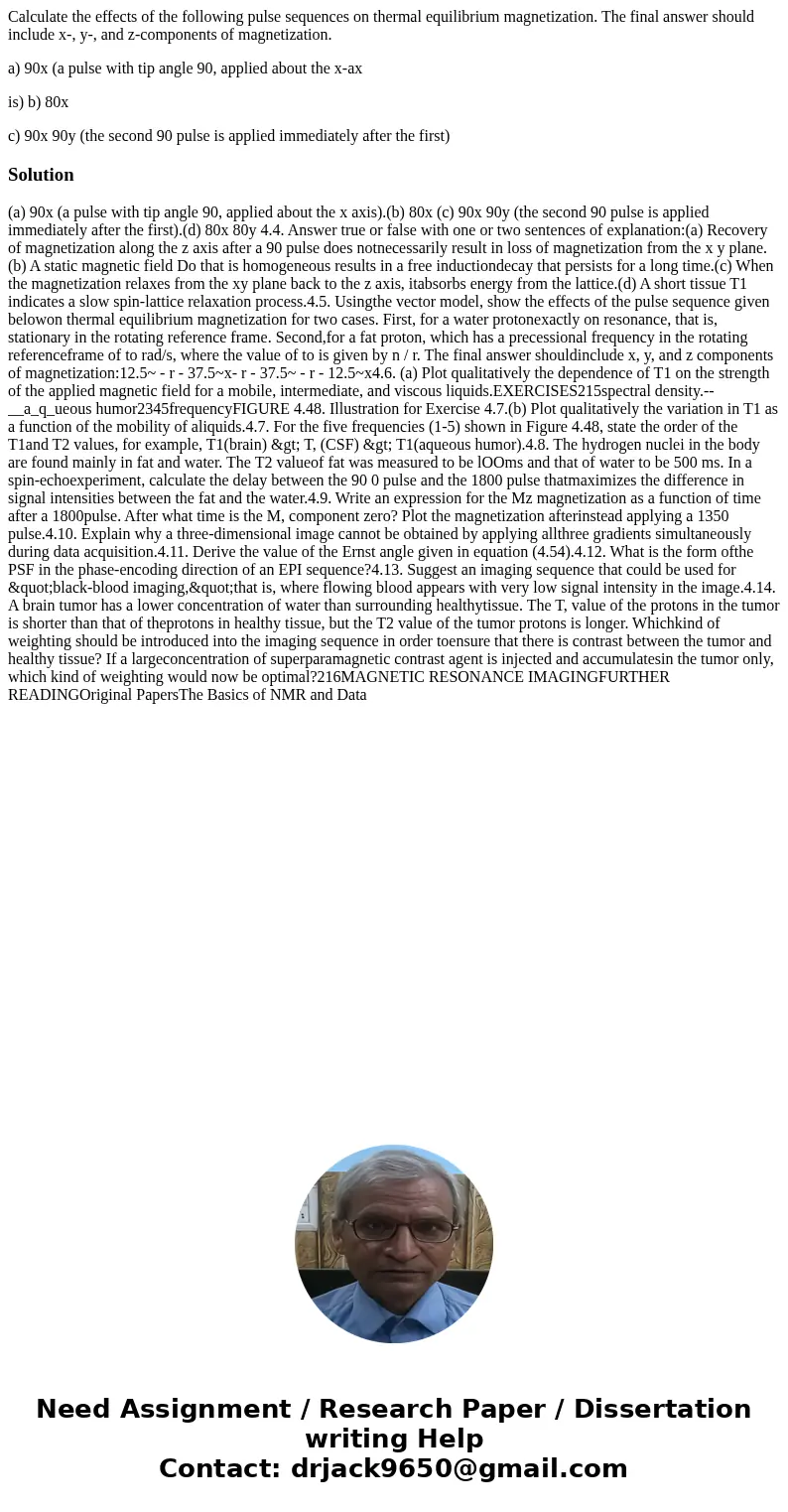Calculate the effects of the following pulse sequences on th
Calculate the effects of the following pulse sequences on thermal equilibrium magnetization. The final answer should include x-, y-, and z-components of magnetization.
a) 90x (a pulse with tip angle 90, applied about the x-ax
is) b) 80x
c) 90x 90y (the second 90 pulse is applied immediately after the first)
Solution
(a) 90x (a pulse with tip angle 90, applied about the x axis).(b) 80x (c) 90x 90y (the second 90 pulse is applied immediately after the first).(d) 80x 80y 4.4. Answer true or false with one or two sentences of explanation:(a) Recovery of magnetization along the z axis after a 90 pulse does notnecessarily result in loss of magnetization from the x y plane.(b) A static magnetic field Do that is homogeneous results in a free inductiondecay that persists for a long time.(c) When the magnetization relaxes from the xy plane back to the z axis, itabsorbs energy from the lattice.(d) A short tissue T1 indicates a slow spin-lattice relaxation process.4.5. Usingthe vector model, show the effects of the pulse sequence given belowon thermal equilibrium magnetization for two cases. First, for a water protonexactly on resonance, that is, stationary in the rotating reference frame. Second,for a fat proton, which has a precessional frequency in the rotating referenceframe of to rad/s, where the value of to is given by n / r. The final answer shouldinclude x, y, and z components of magnetization:12.5~ - r - 37.5~x- r - 37.5~ - r - 12.5~x4.6. (a) Plot qualitatively the dependence of T1 on the strength of the applied magnetic field for a mobile, intermediate, and viscous liquids.EXERCISES215spectral density.--__a_q_ueous humor2345frequencyFIGURE 4.48. Illustration for Exercise 4.7.(b) Plot qualitatively the variation in T1 as a function of the mobility of aliquids.4.7. For the five frequencies (1-5) shown in Figure 4.48, state the order of the T1and T2 values, for example, T1(brain) > T, (CSF) > T1(aqueous humor).4.8. The hydrogen nuclei in the body are found mainly in fat and water. The T2 valueof fat was measured to be lOOms and that of water to be 500 ms. In a spin-echoexperiment, calculate the delay between the 90 0 pulse and the 1800 pulse thatmaximizes the difference in signal intensities between the fat and the water.4.9. Write an expression for the Mz magnetization as a function of time after a 1800pulse. After what time is the M, component zero? Plot the magnetization afterinstead applying a 1350 pulse.4.10. Explain why a three-dimensional image cannot be obtained by applying allthree gradients simultaneously during data acquisition.4.11. Derive the value of the Ernst angle given in equation (4.54).4.12. What is the form ofthe PSF in the phase-encoding direction of an EPI sequence?4.13. Suggest an imaging sequence that could be used for "black-blood imaging,"that is, where flowing blood appears with very low signal intensity in the image.4.14. A brain tumor has a lower concentration of water than surrounding healthytissue. The T, value of the protons in the tumor is shorter than that of theprotons in healthy tissue, but the T2 value of the tumor protons is longer. Whichkind of weighting should be introduced into the imaging sequence in order toensure that there is contrast between the tumor and healthy tissue? If a largeconcentration of superparamagnetic contrast agent is injected and accumulatesin the tumor only, which kind of weighting would now be optimal?216MAGNETIC RESONANCE IMAGINGFURTHER READINGOriginal PapersThe Basics of NMR and Data

 Homework Sourse
Homework Sourse